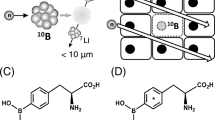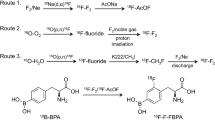Summary
The transport of boronophenylalanine (BPA) and its metabolic fate have been studied in a human uveal melanoma cell line isolated from a primary enucleated tumor. The boronated compound was rapidly incorporated into the cells reaching a peak of incorporation in two hours. This was followed by a trough between 10 and 24 hours and by an increase thereafter. The analogy with the amino acids phenylalanine (Phe) and tyrosine (Tyr) was studied in competition experiments incubating cultures of cell line MK-T, isolated in this laboratory, with [3H]-Phe and [125I]-Tyr, in the presence or absence of various concentrations of BPA, between 0 and 5 min. The presence of BPA severely reduced the uptake of both amino acids. The kinetics of the transport of [3H]-Phe and [3H]-Tyr in the presence of BPA, measured after 10 sec of incubation, showed that the boronated compound exerted a competitive inhibition on both transport systems. The intracellular metabolism of BPA was followed by measuring boron concentration (measured with Ionization Coupled Mass Spectrometry) in subcellular fractions and after membrane extraction by the detergent Triton X-100. The results showed that BPA remained in the supernatant and was not metabolized into macromolecules. These results and the relative absence of melanine in these cells, as observed by electron microscopy, suggest that BPA may be actively transported into melanoma cells but not metabolized. The results may have a relevance in studies on Boron Neutron Capture Therapy.
Similar content being viewed by others
References
Anisuzzam AKM, Alam F, Soloway AH (1990) Synthesis of a carboranyl nucleoside for potential use in neutron capture therapy of cancer. Polyhedron 9: 891–892
Barth RF, Soloway AH, Fairchild RG, Brugger RM (1992) Boron neutron capture therapy for cancer. Cancer 70: 2995–3007
Belkhou R, Mykita S, Meyer L, Sahel J, Abbé J-Ch, Dreyfus H, Massarelli R (1992) Lethal effect of the boron neutron capture reaction on human uveal melanoma cells in culture incubated with borophenyalanine. C R Acad Sci (Paris) 315: 485–491
Coderre JA, Glass JD, Fairchild RG, Roy U, Cohen S, Fand I (1987) Selective targeting of borophenylalanine to melanoma in BALB/c mice for neutron capture therapy. Cancer Res 47: 6377–6383
Coderre JA, Glass JD, Packer S, Micca P, Greenberg D (1990) Experimental boron neutron capture therapy for melanoma: systemic delivery of boron to melanotic and amelanotic melanoma. Pigm Cell Res 3: 310–318
Harper JF (1984) Peritz “F” test: basic program of a robust multiple comparison test for statistical analysis of all differences among group means. Comput Biol Med 14: 437–445
Hatanaka H (1975) A revised boron-neutron capture therapy for malignant brain tumors: II. Interim clinical result with the patients excluding previous treatments. J Neurol 209: 81–94
Hatanaka H, Kamano S, Amano K, Hojo S, Sano K, Egawa S, Yasukochi H (1986) Clinical experience of boron neutron capture therapy for gliomas. A comparison with conventional chemo-immuno-radiotherapy. In: Hatanaka H (ed) Boron neutron capture therapy for tumors. Nishimura Co., Niigata, pp 349–379
Hawthorne MF (1993) The role of chemistry in the development of boron neutron capture therapy of cancer. Angew Chem Int 32: 950–984
Ichihashi M, Mishima Y, Ueda M, Hayashibe K, Hatta S, Funasaka Y, Fujiwara H, Yoshino K (1986) Selective lethal effects of10B-para-borophenylalanine on mouse and human melanoma cells in thermal neutron capture therapy enhanced by tyrosine and phenylalanine deficiency. In: Hatanaka H (ed) Neutron capture therapy. Nishimura Co., Niigata, pp 237–246
Kahl SB, Joel DD, Nawrocky MM, Micca PL, Tran KP, Finkel GC, Slatkin DN (1990) Uptake of anido-carboranylporphyrin by human glioma xenografts in athymic nude mice and by syngeneic ovarian carcinomas in immunocompetent mice. Proc Natl Acad Sci USA 87: 7265–7269
Leukart O, Caviezel M, Eberle A, Escher E, Tun-Kyi A, Schwyzer R (1976) Carboranylalanine, a boron analogue of phenylalanine. Helv Chem Acta 59: 2184–2187
Locher GL (1936) Biological effects and therapeutic possibilities of neutrons. Am J Roentgenol Radium Ther 36: 1–13
Lowry OH, Roseborough NJ, Farr AL, Randall RJ (1951) Protein measurement with the Folin phenol reagent. J Biol Chem 193: 265–275
Manthorpe M, Fagnani R, Skaper SD, Varon S (1986) An automated colorimetric microassay for neuronotrophic factors. Dev Brain Res 25: 191–198
Massarelli R, Belkhou R, Dunel-Erb S, Chevalier C, Abbé J-Ch, Pignol J-P, Moutaouakkil M, Sahel J (1994) Morphological characterisation of human uveal melanoma cell lines. C R Acad Sci 317: 25–33
Mishima Y, Honda C, Ichihashi M, Obara H, Hiratsuka J, Fukuda H, Karashima H, Kobayashi T, Kanda K, Yoshino K (1989) Treatment of malignant melanoma by single thermal neutron capture therapy with melanoma-seeking10B-compounds. Lancet ii: 388–389
Moss RL, Stecher RA, Asmussen F, Huiskamp R, Dewit L, Mijnheer B (1992) The Petten BNCT project. In: Allen BG, Moore D, Harrington B (eds) Progress in neutron capture therapy for cancer. Plenum Press, New York, pp 7–12
Packer S, Coderre J, Saraf S, Fairchild RG, Hansrote J, Perry H (1992) Boron neutron capture therapy of anterior chamber melanoma with p-borophenylalanine. Invest Ophtalmol Vis Sci 33: 395–403
Roberts DC, Suda K, Samanen J, Kemp DS (1980) Pluripotential amino acids. I. L-pdihydroxyborylphenylalanine as a precursor of L-Phe and L-Tyr containing peptides: specific tritiation of L-Phe containing peptides at a final step in synthesis. Tetrahedron Lett 21: 3435–3438
Schinazi RF, Prusoff WH (1978) Synthesis and properties of boron and silicon substituted uracil or 2′-deoxyuridine. Tetrahedron Lett 50: 4981–4984
Soloway AH, Barth RF, Alam F, Carey WE (1986) Boron compounds and boronated antibodies for neutron capture therapy. In: Hatanaka H (ed) Boron neutron capture therapy for tumors. Nishimura Co., Niigata, pp 47–58
Spielvogel BF, Good A, Hall IA, Fairchild RG, Micca PL (1989) Synthesis, antineoplastic activity and biodistribution of boron analogues of amino acids and related compounds. Strahlenter Onkol 165: 123–125
Strasgliotto G, Fankhauser H (1992) Biodistribution of boron sulphydral (BSH) in patients with intracranial tumors. In: Allen BG, Moore D, Harrington B (eds) Progress in neutron capture therapy for cancer. Plenum Press, New York, pp 551–556
Taylor HJ, Goldhaber M (1935) Detection of nuclear disintegration in a photographic emulsion. Nature 135: 341–348
Tjarks W, Gabel D (1991) Boron-containing thiouracil derivatives for neutron capture therapy of melanoma. J Med Chem 34: 315–319
Author information
Authors and Affiliations
Rights and permissions
About this article
Cite this article
Belkhou, R., Abbé, J.C., Pham, P. et al. Uptake and metabolism of boronophenylalanine in human uveal melanoma cells in culture Relevance to boron neutron capture therapy of cancer cells. Amino Acids 8, 217–229 (1995). https://doi.org/10.1007/BF00806495
Received:
Accepted:
Issue Date:
DOI: https://doi.org/10.1007/BF00806495




